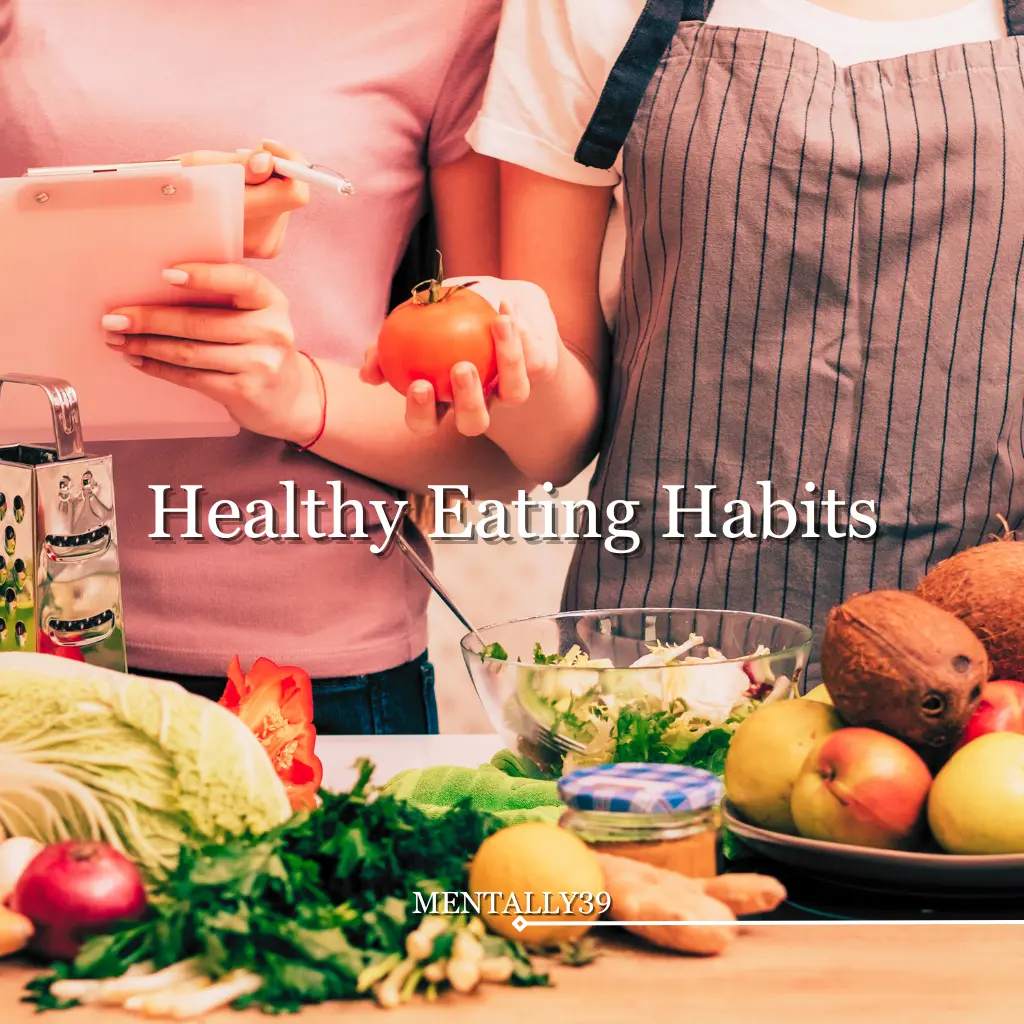Do you ever feel overwhelmed by the different nutrition and healthy eating information? It seems like every week, there’s a new diet or superfood that promises to make you healthier. But it’s important to remember what really matters: developing long-term healthy eating habits that will improve your overall well-being. There is no magic pill; it takes time, dedication, and choosing healthy foods you can eat sustainably.
Table of Contents
This article will look at healthy eating habits and guide you to developing practices that will change your lifestyle. Instead of following strict diets, we will focus on eating balanced meals with nutritious foods. We’ll talk about starting your day with a healthy breakfast and learning how to control your portions and eat mindfully. By the end, you’ll know to make smart choices about what you eat and experience the benefits of a healthier lifestyle.
Healthy Eating Habits #1: Start Your Day with a Nutritious Breakfast
A good day begins with good nutrition; start your mornings by eating a healthy breakfast. This sets the tone for the rest of your day, providing your body and mind with essential nutrients and energy. By being mindful of what you eat in the morning, you can establish healthy habits that will benefit you in the long run.
When preparing your breakfast, choose nutrient-dense foods that will keep you feeling full and focused throughout the morning. Ensure to incorporate various food groups, including grains, lean proteins, fruits or vegetables, and healthy fats. This combination provides a range of vitamins and minerals and helps regulate blood sugar levels, reducing cravings.
Ditch the donuts, the drinks with added sugars, and the cereals filled with things most of us can’t pronounce. Some of the most popular cold drinks contain over 67 grams of sugar. That’s almost 3 times the recommended allowance. 67 grams is just over 1/3 of a cup! And don’t say you don’t have time; it takes less than 5 minutes to crack, whisk, and microwave eggs. Add in some avocado toast, and you’re set.
Healthy Eating Habit #2: Say Goodbye to Processed Foods
Imagine strolling through a farmers’ market, the air filled with the delightful aroma of fresh produce. As you browse through vibrant displays of colorful fruits and vegetables, it becomes evident that nature’s bounty is far more appealing than anything that could be manufactured in a factory.
Processed foods are everywhere in our modern diet, especially the Western diet, but their convenience comes at a cost. These highly processed “foods” are often high in calories and contain unhealthy additives, unhealthy fats, and sodium. They contribute heavily to obesity and numerous health issues. You will feel better when you start eating well, drink water, and add some fruits and vegetables.
Choose whole foods. I’ll give you some advice: if you can’t pronounce the ingredient, don’t eat it. Foods should not sound like they just came from a chemistry lab. Do you really want the food you eat to be filled with chemicals and artificial colors?
Healthy Eating Habit #3: Fill Your Plate with Colorful Fruits and Vegetables
Habit 3 is having a variety of colorful fruits and vegetables on your plate. It is visually appealing and provides you with a wide range of nutrients. There are several options to choose from when it comes to adding color to your meals.
First, red fruits and vegetables such as strawberries, watermelons, and bell peppers contain lycopene, an antioxidant that may help reduce the risk of heart disease and certain cancers.
Secondly, orange foods like carrots, sweet potatoes, and oranges are rich in beta-carotene, which converts into vitamin A in the body. This nutrient is essential for maintaining healthy eyesight and a strong immune system.
Next, yellow fruits and vegetables like bananas, pineapples, and bell peppers are packed with important vitamins and minerals such as vitamin C and potassium. These nutrients support a healthy immune system and help regulate blood pressure.
Leafy greens like spinach, broccoli, and kale fall into the green category. They are abundant in vitamins A, C, and K and minerals like iron and calcium. Including these greens in your diet can greatly benefit your overall health.
Add blueberries, grapes, and eggplants to your plate for blue and purple options. These foods contain anthocyanins, which are antioxidants that may improve cognitive function.
Last, don’t overlook white fruits and vegetables like cauliflower, onions, and pears. Although they may not be as vibrant in color, they still offer important nutrients such as fiber and vitamin C.
Remember to try to eat a variety of colors in your meals to ensure you receive a diverse array of vitamins, minerals, and antioxidants. By doing so, you can promote optimal health and well-being.

Habit #4: Make Water Your Best Friend
Water is often overlooked in healthy eating habits but vital for keeping our bodies alive. Staying hydrated is essential for our bodies to function properly and for us to feel good overall. Most people are not drinking enough water; many do not come close to the 8 glasses of water a day. No, your 8 cups of cream, sugary coffee, or favorite energy drink don’t count. Plain old water is what you need; unsweetened tea is fine.
Why do you need so much water? Water eliminates harmful toxins in our bodies, aids digestion, facilitates nutrient absorption, and ensures the optimal functioning of our organs so we stay healthy.
Healthy Eating Habit #5: Embrace the Power of Whole Grains
When it comes to maintaining our overall health, it is important not to overlook the importance of whole grains. Unlike refined grains, which have been stripped of essential components, complete grains retain all their nutrients. This means they are rich in fiber, vitamins, minerals, and antioxidants.
There are numerous benefits associated with consuming whole grains, such as quinoa, brown rice, whole wheat bread, and oats. These contain lots of fiber, which we need for proper bowel movements, plus they help you feel fuller longer.
Habit #6: Choose Lean Proteins for Optimal Health
Regarding healthy eating habits, focusing on lean proteins is important. These proteins are incredibly beneficial because they aid in muscle growth and tissue repair and support various bodily functions. However, it’s important to note that not all proteins are created equal.
To ensure you’re consuming the best proteins, opt for lean meats such as skinless poultry and fish. Also, consider legumes, tofu, and low-fat dairy products as a protein source. These options are packed with essential nutrients while being low in unhealthy fats. And like fiber, proteins will help you feel full.
Be mindful of saturated fats, especially in sausages, bacon, butter, and fatty cuts of meat. Eating in moderation is key here; occasionally, fatty steak is fine, just not five nights a week. 1 piece of bacon, not 6, to go with your biscuit.
Habit #7: Practice Portion Control
Controlling how much we eat is essential to maintaining a healthy diet. It involves being mindful of how much food we consume during each meal, ensuring that we neither overeat nor undereat. By practicing portion control, we can establish a positive relationship with food and effectively manage our weight.
It is important to understand the appropriate quantity of food to consume and to listen to our body’s signals of hunger and fullness. Familiarize yourself with recommended serving sizes for different types of food. This knowledge will enable you to decide how much to eat.
Secondly, consider using smaller plates. Doing so creates an illusion of consuming more food than we actually are, leading to greater satisfaction while consuming fewer calories.
Plan by preparing meals or snacks in advance can prevent mindless snacking or excessive consumption. Utilizing containers or dividers can assist in ensuring that we have the appropriate portion sizes readily available.
Remember, it is about finding a balance and providing our bodies with the necessary amount of food.

Habit #8: Cook at Home and Control Your Ingredients
Cooking at home is more than just a way to satisfy your hunger – it’s an opportunity to take control of your health and well-being, it means you can have a healthy snack or meal without a ton of additives.
When you prepare meals from scratch, you have the power to choose exactly what goes into your dishes.
This means you can avoid unhealthy additives like excessive salt or sugar and harmful preservatives commonly found in processed foods.
By cooking at home, you encourage healthy eating habits, creating meals that align with your needs and preferences. If you have certain health conditions, cooking at home makes more sense. Find a healthy recipe and make the swaps needed to maintain a healthy weight.
Plus, cooking at home has the potential to bring families closer together. As loved ones gather around the table to enjoy homemade meals, the act of preparing food becomes an expression of love and care for oneself and those who matter most.
Habit #9: Slow Down and Savor Your Meals
Meals today are often hurried. We grab a quick bite on the go or eat while scrolling through our phones, barely paying attention to what we’re consuming. However, one of the most essential healthy eating habits you can use is to slow down and savor your meals.
By taking the time to appreciate and enjoy what you’re eating truly, you not only enhance your overall dining experience but also promote better digestion and portion control.
When we rush through meals, we don’t give our bodies enough time to register fullness, leading to overeating. By consciously slowing down, you allow your brain to catch up with your stomach’s satiety signals.
Take smaller bites, chew thoroughly, and pause between each mouthful. Engage all your senses – notice your food’s colors, aromas, flavors, and textures. Cultivate gratitude for each meal as a nourishing experience that fuels both body and soul.
Habit #10: Listen to Your Body and Practice Mindful Eating
Our last healthy eating habit encourages us to slow down, pay attention, and practice mindful eating. This important habit helps us connect with our bodies and have a healthier relationship with food.
Mindful means being fully present in the moment, enjoying each bite, and listening to our bodies. Not doom scrolling social media. By paying attention to when we are hungry or full, we can better understand whether we need to eat or are just bored or feeling emotional.
Eating mindfully makes us aware of each meal’s flavors, textures, and feelings. Imagine enjoying a delicious strawberry on a sunny day – feeling its sweetness explode in your mouth as you appreciate its bright color and refreshing taste. Mindful eating lets us experience these moments of pure joy with every bite. By practicing this habit regularly, we learn to appreciate the nourishment that food gives us.
Healthy eating habits can improve your life; consuming a healthy balanced diet gives your body the necessary fuel to maintain good health and flourish. Just changing your eating habits a little can significantly impact your overall well-being.
Approach this journey with optimism, recognizing that each meal presents an opportunity to prioritize self-care and establish a healthier lifestyle. And don’t forget to incorporate some physical activity several times a week to really boost your health, that and healthy eating habits can go a long way.
20+ Years as a Special Education Teacher
NASM Certified Nutrition Coach,
Certified Trauma Informed Trainer
Mindset and Motivation Master Life Coach
